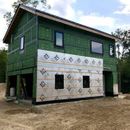Advice on Taping Exterior Polyiso
I’m in the process of putting up 2″ exterior polyiso around a 24′ x 32′, two story house in climate zone 5 (central NH). There’s a rain screen between the polyiso and siding (when the siding goes up). So far, so good. For the most part, the pieces of insulation have fit fairly tightly against each other, but I do have small gaps here and there where there aren’t perfect fits. I’m anticipating more gaps on the second story when insulating around an upper level deck and bigger windows.
I’ve read different posts about whether to tape the joints or not. What I haven’t seen is a fuller explanation about whether there’s risk in moisture getting trapped behind the tape and my Zip sheathing (which is my taped WRB). I’m leaning toward taping the joints, but would love advice on whether there’s a genuine risk of moister being trapped between the insulation and sheathing.
As an aside, would love advice on the best options to bring the exterior insulation up under the overhang and eaves, below the soffits. Not sure whether I should bring the insulation all the way to the top and attach the soffit vents to the siding or stop the insulation short of where the soffits will connect to the sheathing and not insulate that last little bit that will be inside the soffit.
GBA Detail Library
A collection of one thousand construction details organized by climate and house part










Replies
In the case that you had water getting to the insulation layer, I would tend to think that you'd be at a higher risk of it being trapped behind the insulation if you *didn't* tape the seams. The only way water would penetrate to the backside of the sheathing is through a random penetration, and there probably isn't many of those in your wall.
In previous posts on the subject, I read that taping the joints is optional, but might improve R value performance. But see the last comment in the thread from AppliedBuildingScience regarding trapping moisture (my ZIP sheathing is my WRB and is taped with service penetrations spray foamed and/or flashed).
https://www.greenbuildingadvisor.com/question/taping-rigid-foam-on-wall-exterior-when-thats-not-the-air-barrier
Scott,
I would suggest running your foam up to the level of your second floor ceiling. That will be above the level of your soffit. Once you have the foam installed, attach a 2"x4" through it into the framing at the same level of your rough fascia. That will provide backing for the soffits.
Thanks Malcom. Same idea on the gable ends too, I imagine?
Scott,
I can't remember from past discussions whether the ceiling is pitched or flat. If it is flat you have the option of continuing the foam up the gable ends (although it doesn't do much), or again stopping it at the ceiling and furring out the wall instead.
Edit: Bill makes a good point. The foam should extend up to the top of the attic insulation, not just to the ceiling.
Taping the polyiso is mainly to make a good air barrier. Since you have taped Zip sheathing already, it's less important to tape the polyiso. I'd probably tape the polyiso myself, using a foil tape, just for some redundancy. Small gaps between foam panels aren't a big deal, but you can fill them with canned foam if you want to.
I would do as Malcolm suggests, but I'd run the polyiso up past the upper level ceiling and stop at about where the level of insulation on your attic floor would be instead of stopping at the level of the ceiling. Assuming you're using loose fill insulation, that "top of the insulation" is probably around a foot to 16" or so above the upper level ceiling for R49 worth of blown cellulose. After that, I'd use lumber to furr the wall out to whatever the thickness of the foam would be so that you'd have a consistent plane for your siding. I'd do the same thing on the gable ends. The idea is to not waste polyiso insulating areas of vented attic that are essentially at outdoor temperatures anyway.
Bill
Scott,
I hope you plan on writing all of this up in an article at the end! It's been interesting to follow along with.